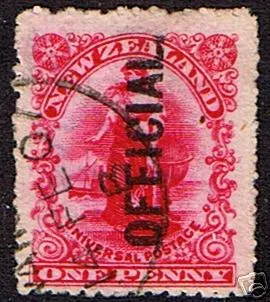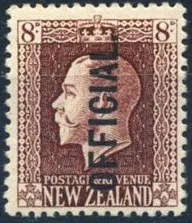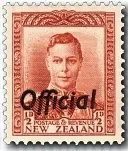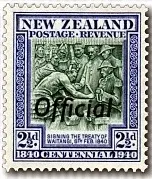The first 'OFFICIAL' stamps, stamps designed for use by Government Departments, was issued in 1882. In January 1907, the New Zealand government decided that all public service mail should use these special stamps overprinted with the word Official. It was not until 1913 that mint official stamps could be sold to the public.
As this post will only show Official Stamps, that appeared in a number issues, particularly definitive issues, we have provided links to take you to full, more detailed posts on each issue.
Postal 1882 Fiscal Official. Queen Victoria Fiscal Stamps - Part Two.
Three of the Fiscal stamps were overprinted 'OFFICIAL' for postal use by government departments. Since the officials were never used for fiscal purposes, there is no difficulty recognising valid postal cancellations on these stamps.
£1 Pink. 2/- Blue. 5/- Green.
When New Zealand issued the 1898 Pictorials four of them were overprinted for use by Government Departments. These four values had the word "OFFICIAL" in bold capitals printed vertical over each stamp in much the same way as had been done with the earlier Fiscal Issue in 1882. Government Departments were allowed to use them but they weren't instructed to.
1/- Kea and Kaka. 2/- Milford Sound / Mitre Peak.
3d - Huias. 5/- Mount Cook.
In 1900, a number of the lower value pictorial stamps from the 1898 issue were replaced. The designs and colours of the penny and fourpence stamps were swapped as the two-tone 1898 penny stamp was too difficult and costly to print in large quantities. The stamps were originally intended to be printed this way around in 1898, but a printers error saw them transposed.
½d Green - Mount Cook. 2d - Pembroke Peak. 6d - Red Kiwi.
1901 Penny Universal Official 1901 Universal - 1909 Dominion.
A penny Official was also required to meet a reduction in postal rates. The 1d Universal was issued along with an overprinted Official version to meet this increased demand. Its an interesting story so visit our post on this stamp via the link above.
1d Universal. (Zealandia).
1907 Redrawn Pictorials Official. 1901 Universal - 1909 Dominion. 1898 The First Pictorial Issue.
By 1906 the printing plates for the 1898 Pictorials ½d, 3d, 6d and 1/- stamps were worn and needed replacing. The 3d, 6d and 1/- stamps were reduced in size so that 240 stamps could be printed per sheet giving a substantial saving in printing costs. Two of these new stamps, the 1d Universal and the 6d Kiwi, were also overprinted "OFFICIAL" at the same time.
1d - Zealandia. 6d - Red Kiwi.
Because the 1898 Pictorials had only just been issued when Queen Victoria died and her son Edward VII ascended to the throne, New Zealand stamps bearing the King's head were not issued until November 1909, and even then they were not distributed widely until stocks of the pictorials had been exhausted. In the end the stamps bearing his image were only on sale for six months before he died. Once issued, most values remained on sale until 1915, and the five penny and eight penny stamps were still in use in 1920, ten years after King Edward's death. The one penny dominion was still in use right up until 1926.
Only five of the King Edward VII definitives plus the 1d Dominion received an "OFFICIAL" overprint. It seems that Government Departments could get by with a much smaller selection of stamps than the public could.
½d - Green. 1d - Dominion. 3d - Brown.
6d - Red. 8d - Blue. 1/- Orange.
A new king took the throne and a new set of stamps was considered by New Zealand, although for various reasons, it too nearly 6 years before this new set was issued. It became a complex set, going through two different printing processes and two different printers. I have only included brief commentary here, plus only the stamps overprinted "OFFICIAL." Visit our post on this issue via the link above.
1/- - Orange. 3d - Brown/Chocolate. 4d - Violet (1916).
6d - Red. 8d - Brown (1922). 9d - Olive Green.
1½ - Grey/Black Official.
Surface printing of the 1½d stamp was introduced during the First World War to reduce costs and because the halfpenny war tax on all mail except newspapers had led to unexpected demand for this value. The original recess printed 1½d stamp had been intended for parcel rates, not standard mail.
1915 King George V Official Surface Print. 1915 King George V.
½d - Olive Green. 1½ - Grey/Black. 1½ - Orange/Brown.
2d - Yellow (1916). 3d - Brown/Chocolate.
The halfpenny stamps were surface rather than recess printed to save costs because of the larger quantities expected. Surface printing, which is much less expensive than recess printing, had only been intended for the halfpenny green stamp. However, cost savings during the First World War combined with the halfpenny war tax led to unexpected demand for slightly higher values and the decision was made to surface print the other values in this set as well.
The grey black surface printed 1½d stamp replaced the 'local' surface print (See 1915 King George V Local Print issue above) which were not engraved with sufficient accuracy. Perkins, Bacon in London produced new 1½d plates at the same time as the new 2d and 3d plates were produced. The colour of the 1½d stamp was later changed from grey black to orange brown because light cancellations did not show up on the original stamp.
1d - Field Marshall. 2/- Blue Admiral.
The 1926 Admirals are often included with the 1915 definitive issue as they were intended to be an add-on to that original issue. Only two of the Admirals received an 'OFFIVIAL' overprint. In both designs King George V is shown, on the red stamp dressed as a Field Marshall on the blue stamp now dressed as Admiral of the Fleet.
1935 Pictorials Official. 1935 Pictorials.
The "Official" overprint was different to those before it as the full capital letters format was dropped in favour of small letters. All other Official Stamps used this new format except for the Queen Elizabeth II set that didn't require an overprint since the word "Official" was incorporated into the design.
The 1935 Pictorials was a second break-away from the usual heads of Sovereigns definitive issues. Since the 1898 Pictorials had been so successful it was decided to do it again with designs being chosen from a completion where people were invited to submit. Most of the designs were overprinted.
½d - Fantail. 1d - Kiwi. 1½d - Cooking.
2d - Whare. 2½d - Mount Cook.
3d - Wahine. 4d - Mitre Peak. 6d - Harvest.
8d - Tuatara. 9d - Maori decoration. 1/- Tui.
2/- Landing of Captain Cook.
The 1938 King George VI Definitive Issue is divided into two groups. The thirteen lower values were single colour designs showing the king in a full-face portrait. The four higher values shows the same portrait but in a two colour design. In the OFFICIAL set there are only twelve lower values and two higher values. Again the more modern 'Official' was used for the overprint.
1938 - ½d Green. 1946 - ½d Chestnut.
1938 - 1d Scarlet. 1941 - 1d Green. 1938 - 1½d Chocolate. 1951 - 1½d Scarlet.
1947 - 2d Orange. 1941 - 3d Blue. 1947 - 4d Magenta.
1947 - 6d Carmine. 1947 - 8d Violet. 1947 - 9d Brown/Sepia.
1947 - 1s Brown & Claret. 1947 - 2s Brown & Green.
Planning for the commemorative 1940 Centennial of British Sovereignty issue began in 1936. The stamps were designed by James Berry and Leonard Mitchell, both of Wellington and were selected from designs submitted by 19 artists. Most of the stamp designs were dual-colour. The set was accompanied with an 'Official' set comprising 11 values.
Today the 1940 Centennials are seen as one of the better pictorial sets with each telling an interesting story about early New Zealand.
½d - Landing of First Maori. 1d - Captain Cook and the Endeavour.
1½d - British Sovereigns. 2½d - Treaty of Waitangi.
2d - Abel Tasman. 3d - Settlers at Petone Beach.
4d - Transport - Land, Sea and Air. 6d - First shipment of frozen mutton.
8d - Maori Council. 9d - Gold Mining dredge.
1/- A Giant Kauri.
"Tane Mahuta" God of the Forest
From the late 1940s, James Berry had proposed that Official Government stamps should have their own design - along the lines of the Government Life Insurance issues. James produced sample designs featuring native flowers and eventually the New Zealand Post Office agreed but opted for a simple design featuring the Queen's head. This made the 1954 Official issue unique as the only issue designed specifically for government department use. All previous Official stamps were over-prints of the then current definitive or pictorial issues. This was the last New Zealand Official issue as stamps for general official purposes ceased altogether when this issue was withdrawn in March 1965.
This design is also very similar to one James Berry designed for the 1957 Ross Dependency Issue. Both designs depicted an informal portrait of Queen Elizabeth II set against a background pattern made up of the letters "N" and "Z".
1d - Official. 1½d - Official.
2d - Official. 2½d - Official. 3d - Official.
4d - Official 9d - Official.
1/- Official. 3/- Official.


1961 Official. 1959 Official.
Some of the images in this post were used with permission from the illustrated catalogue of StampsNZ

















































































Comments
Post a Comment
We appreciate your engagement with our content. To ensure a respectful and constructive community, please take note of the following:
- No Spam, Please: We do not tolerate spammy or promotional comments. Any such comments will be promptly removed.
- Moderation in Place: All comments are moderated to maintain a positive and inclusive environment. Please be patient, as it may take a little time for your comment to appear.
- Sign In with Google: To comment, please sign in using your Google account. This helps us maintain the integrity of our community and allows for better interaction.